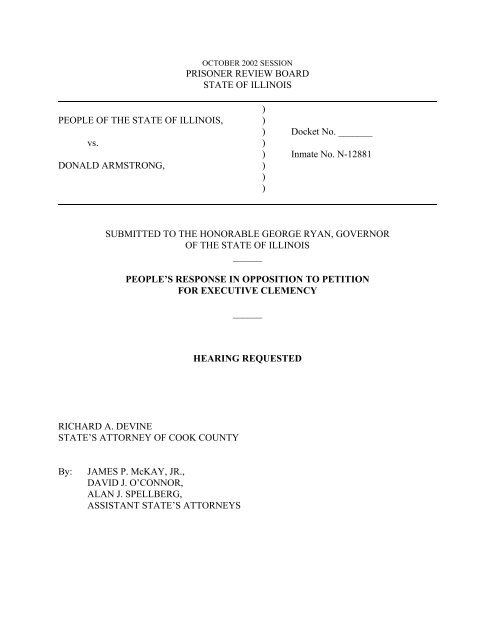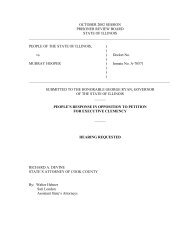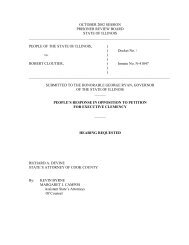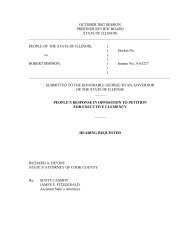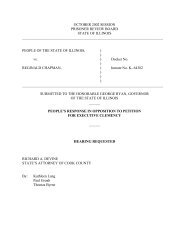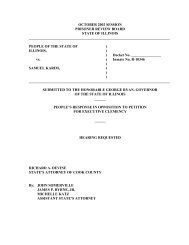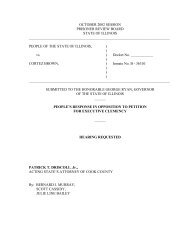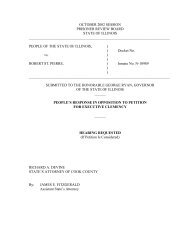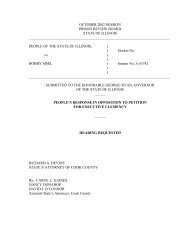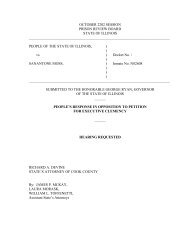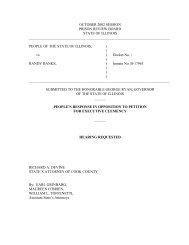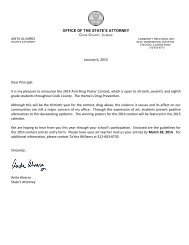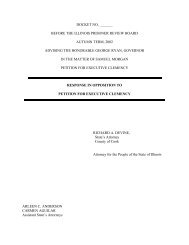Donald Armstrong - Cook County States Attorney's Office
Donald Armstrong - Cook County States Attorney's Office
Donald Armstrong - Cook County States Attorney's Office
You also want an ePaper? Increase the reach of your titles
YUMPU automatically turns print PDFs into web optimized ePapers that Google loves.
OCTOBER 2002 SESSION<br />
PRISONER REVIEW BOARD<br />
STATE OF ILLINOIS<br />
PEOPLE OF THE STATE OF ILLINOIS,<br />
vs.<br />
DONALD ARMSTRONG,<br />
)<br />
)<br />
) Docket No. _______<br />
)<br />
) Inmate No. N-12881<br />
)<br />
)<br />
)<br />
SUBMITTED TO THE HONORABLE GEORGE RYAN, GOVERNOR<br />
OF THE STATE OF ILLINOIS<br />
______<br />
PEOPLE’S RESPONSE IN OPPOSITION TO PETITION<br />
FOR EXECUTIVE CLEMENCY<br />
______<br />
HEARING REQUESTED<br />
RICHARD A. DEVINE<br />
STATE’S ATTORNEY OF COOK COUNTY<br />
By:<br />
JAMES P. McKAY, JR.,<br />
DAVID J. O’CONNOR,<br />
ALAN J. SPELLBERG,<br />
ASSISTANT STATE’S ATTORNEYS
OCTOBER 2002 SESSION<br />
PRISONER REVIEW BOARD<br />
STATE OF ILLINOIS<br />
PEOPLE OF THE STATE OF ILLINOIS,<br />
vs.<br />
DONALD ARMSTRONG,<br />
)<br />
)<br />
) Docket No. _____<br />
)<br />
) Inmate No. N-12881<br />
)<br />
)<br />
)<br />
I.<br />
HISTORY OF THE CASE<br />
On February 4, 1992, petitioner <strong>Donald</strong> <strong>Armstrong</strong>, a lifelong criminal, brutally murdered 86<br />
year old Marion Smigiel by clubbing her to death with her own cane as she sorted the garbage in her<br />
garage. The beating was so savage that it left a five-inch hole in Mrs. Smigiel’s skull and broke her<br />
metal cane into pieces. The sole purpose for this barbaric murder was to steal from Mrs. Smigiel,<br />
and petitioner happily collected $25 after he sold her television set to his brother. To this day,<br />
petitioner has never claimed that he is innocent of these crimes, nor has he ever expressed any<br />
remorse. Instead, he brazenly chastised his jury after he was sentenced to death, calling them<br />
“murderers just like [him].” Also, even though he has spent most of his adult life in prison,<br />
petitioner has made a career out of breaking the rules and attacking others, making it clear that he is<br />
unable to live in or out of jail without preying upon those around him.<br />
On direct appeal, the Illinois Supreme Court affirmed petitioner’s convictions and sentences,<br />
1
ejecting each of his 25 claims of error and finding that he was properly found guilty and sentenced<br />
to death, stating that the evidence of petitioner's guilt was “overwhelming” and that “[i]t is clear<br />
from the record that the defendant intended to kill his victim: he beat her to death with her cane,<br />
smashing her skull into three pieces.” People v. <strong>Armstrong</strong>, 183 Ill. 2d 130, 151-52, 700 N.E.2d 960<br />
(1998) (See Exhibit A).<br />
Since being sentenced to death in 1995, <strong>Armstrong</strong> has continued to engage in violent and<br />
threatening behavior to all those around him. He has repeatedly attacked guards and other inmates<br />
and has been disciplined numerous times for sexual misconduct, possession of dangerous contraband<br />
including a three-inch long piece of plexiglass sharpened to a point and insolence. Also, even<br />
though he is on death row and in a highly restricted setting, the Department of Corrections deemed it<br />
necessary to repeatedly reduce his grade and place him in segregation as the only means of<br />
controlling his dangerous behavior. (See Group Exhibit B)<br />
II.<br />
FACTS OF THE CASE<br />
On February 4, 1992, at about 9 a.m., <strong>Office</strong>r Luz Nieves was driving her marked squad car<br />
near the intersection of Kildare and Haddon Avenues in Chicago when she observed an elderly<br />
woman named Mary Leppig standing without a jacket. (R. I9-10) <strong>Office</strong>r Nieves noticed that the<br />
woman seemed nervous and upset and rolled down the window to ask if everything was alright. (R.<br />
I10) Leppig told Nieves that she was worried about her landlady Marion Smigiel because the rear<br />
door to Smigiel's apartment and the service door to the garage were both open. (R. I10) Leppig also<br />
stated that she had called out Smigiel's name several times but did not receive an answer. (R. I10)<br />
2
Leppig then asked <strong>Office</strong>r Nieves to see if anything was wrong. (R. I10)<br />
Nieves then proceeded to the L-shaped apartment building on the corner of Haddon and<br />
Kildare and accompanied Leppig through a gangway that led to the backyard. (R. I11) When she got<br />
to the backyard, Nieves noticed that the service door to the garage was open and that there were keys<br />
dangling from the outside lock. (R. I12) <strong>Office</strong>r Nieves suspected something was wrong and called<br />
for backup. Shortly thereafter, <strong>Office</strong>r Michael Fine arrived and Nieves asked him to accompany her<br />
into the garage. (R. I12)<br />
As they approached the garage, <strong>Office</strong>r Nieves turned on her flashlight and noticed plastic<br />
garbage bags laying in the middle of the doorway. (R. I13) As she walked over the bags, Nieves<br />
discovered the body of an elderly woman lying on the floor in a pool of blood. (R. I13-14) <strong>Office</strong>r<br />
Nieves also noticed that a cane that was covered in blood and had been broken in half was laying<br />
next to the body. (R. I14) Blood was "everywhere" in the garage, including on the bottom of the<br />
closed overhead garage door and the car that was parked next to the woman. (R. I14) <strong>Office</strong>r Nieves<br />
did not see any signs of life, and when she got close to the body, she saw a large open wound on the<br />
victim's head. (R. I14) (See Exhibits C,D,E,F,G,H,I & J) After she called for an ambulance, the<br />
medical examiner, the detective unit and the crime lab, <strong>Office</strong>r Nieves spoke with some tenants from<br />
the building and learned the victim's name, age and that she lived on the first floor of the building.<br />
(R. I15-16) Ralph Disabato, a tenant of the victim's building for 30 years, explained that although<br />
the victim was stooped over and used a cane as a result of arthritis and foot surgery, she would<br />
collect the garbage from the chutes every evening at 6 p.m. and then sort it in the garage. (R. G300-<br />
04) The victim would also collect the rent on the last day of the month. (R. G303)<br />
When <strong>Office</strong>r Nieves went to Smigiel's apartment, she found the door open and a bloodstain<br />
3
on the keyhole. (R. I16, I29) As she entered the apartment, she noticed that unplugged television set<br />
was sitting on the kitchen table. (R. I16) When she went into the bedroom, Nieves saw that it had<br />
been "ransacked"; the mattress had been up-ended and the drawers were searched. (R. I17) In the<br />
living room, <strong>Office</strong>r Nieves observed that the drawers in the desk had also been searched, but when<br />
she examined them, she found a social security check for $683 and $1580 in cash. (R. I17, I34)<br />
Nieves also noticed that the TV was missing from the TV stand and could tell from the dust marks<br />
that the set on the kitchen table was too small to have made those marks. (R. I17) Nieves later<br />
learned from some tenants in the building that Smigiel kept the smaller television in her bedroom.<br />
(R. I18)<br />
Also, after speaking with the tenants, <strong>Office</strong>r Nieves learned that Makowski, a resident of a<br />
second floor apartment, would have almost daily arguments with the victim and was suspected of<br />
pilfering small amounts from her. (R. I18, I137, I38) Nieves then began looking for Makowski, a<br />
white, 5'8" tall male with a mustache. (R. I37, I41) She first went to his apartment and eventually<br />
found him hiding on the third floor landing. (R. I19) The police then recovered from Makowski's<br />
apartment a blue towel and a pair of blue jeans, both of which appeared to be blood-stained. (R.<br />
I123; I153-54) Makowski was then taken to the police station for questioning. (R. I19) Serology<br />
tests revealed that the stains were human blood, but matched Makowski's blood type and not the<br />
victim's. (R. I124; I153-54) Makowski was then released from police custody, but was later arrested<br />
and charged with the victim's murder the following August. (R. I40, I41, I43)<br />
After the evidence technicians processed the crime scene, photographed the victim's body<br />
and collected the evidence, they determined that there were no discernible fingerprints on the broken<br />
cane, and the only identifiable fingerprints in the garage and the victim's apartment were those of the<br />
4
victim herself. (R. I124-25; I149-50) The tests also determined that all of the blood found at the<br />
crime scene matched the victim. (R. I152-53)<br />
The next day, February 5, 1992, the victim's body was brought to the <strong>Cook</strong> <strong>County</strong> Medical<br />
Examiner's <strong>Office</strong> for an autopsy. (R. G319) Three pieces of bone that had broken off the victim's<br />
skull also accompanied the body. (R. G319) The victim was first weighed and measured and found<br />
to be 5'4" tall and 123 pounds. (R. G320) Dr. Edmund Donoghue's exam revealed 15 instances of<br />
external injury: seven lacerations or tears to various parts of the victim's scalp on the back of her<br />
head accompanied by multiple fractures of the skull underneath; a scraping away of the top layer of<br />
skin on the right side of her head; and numerous bruises to the victim's head, face and shoulder. (R.<br />
G320-22)<br />
Dr. Donoghue's internal exam revealed 10 evidences of injury: multiple fractures that had<br />
divided the victim's skull into more than one piece; a large open defect or hole measuring 5.0 x 2.5<br />
inches which was caused by the multiple fractures and resulting in some bones from the victim's<br />
skull to fall out of the back of her head; multiple hemorrhages, including one over the brain; multiple<br />
lacerations to the right occipital lobe of the brain; and two bite marks to the tongue which Dr.<br />
Donoghue opined were caused when it was caught between the jaws as a blow struck the victim's<br />
head. (R. G323-25)<br />
Dr. Donoghue concluded that the victim's bruises on her face and shoulder were consistent<br />
with being struck with a metal cane and falling face first onto concrete. (R. G328-29) He also<br />
determined that the injuries to the back of the victim's head were consistent with being struck by an<br />
object like a metal cane. (R. G332) Dr. Donoghue opined that the victim died of cranial cerebral<br />
injuries to the skull and brain as a result of blunt trauma. Dr. Donoghue believed that the victim<br />
5
suffered between five and ten blows to her head, shoulder and face, but could only be certain that<br />
there was more than one blow. (R. G336, G339, G340)<br />
Several months later, on July, 30, 1992 at approximately 7:15 p.m., Lamark Odell was<br />
standing on the street near his house at 5715 West Ohio with his friend Dwight Beard and his father<br />
Noba Odell, when they were approached by petitioner and his brother Derrick <strong>Armstrong</strong>. (R. I53-<br />
54, I58) Thereafter, the police were called and when they arrived, petitioner ran away. (R. I58)<br />
Lamark Odell told the police what happened and then he and Noba went with the officers to the 15th<br />
District Police Station. (R. I59) Detectives Michael Puttin and Dennis Walsh were then called to that<br />
station because the Odells had some information regarding a homicide. (R. I127)<br />
When the detectives arrived at the police station at about 8:45 p.m., they learned that the<br />
officers were investigating an unrelated incident that had occurred that evening. (R. I128) After<br />
speaking to the officers and the Odells, Detectives Walsh and Puttin took the Odells to see where<br />
petitioner lived. (R. I60; I129) Once Lamark pointed out petitioner's house, the detectives proceeded<br />
to take the Odells home. (R. I129) As they were driving west on Division near Cicero, Lamark told<br />
the detectives that he saw petitioner walking east on the south side of the street. (R. I61; I130) After<br />
verifying which person Lamark was referring to, Detective Puttin made a U-turn, pulled over to the<br />
curb and he and Walsh approached petitioner. (R. I61; I130) Puttin asked petitioner his name and he<br />
replied "<strong>Donald</strong> <strong>Armstrong</strong>." (R. I130) Petitioner was placed under arrest for what had happened<br />
earlier that evening and was then transported to Area 4 Police Headquarters in a different car. (R.<br />
I61-62; I131) The Odells also went there and Lamark told the detectives about a conversation he had<br />
with petitioner approximately six months earlier. (R. I62; I132)<br />
At that time, Lamark walked out of a liquor store near the intersection of Chicago and<br />
6
Menard Avenues when petitioner approached him and asked for money so he could get out of town.<br />
(R. I62-63) Petitioner explained that he had to get out of town because he had killed an old lady in a<br />
garage near Division and Kostner when he tried to get her money and she refused to give it to him.<br />
(R. I63-65) Petitioner also said that he had gotten $50 or so after the killing. (R. I65) Petitioner then<br />
asked Lamark for $30, but Lamark refused. (R. I65)<br />
After speaking to the Odells, Detectives Puttin and Walsh began to investigate the murder of<br />
Marion Smigiel and proceeded to interview members of petitioner's family and other individuals<br />
throughout the night. (R. I132) One of the persons they interviewed was petitioner's brother Ronald<br />
<strong>Armstrong</strong> (R. I143), who told them that near the end of January 1992, he and petitioner were<br />
drinking beer with Makowski at Makowski's apartment at Haddon and Kildare when Makowski told<br />
them that he had previously taken $200 from under his landlady's tablemat when she went into the<br />
garage. (R. I78-79) Makowski explained that she had a lot of money on the third of every month<br />
because the tenants had paid their rent. (R. I79) Petitioner and Makowski then discussed what to do<br />
about getting the landlady's money and decided to rob her on the third of the following month. (R.<br />
I79-80) Ronald and petitioner left Makowski's apartment shortly thereafter and Ronald told<br />
petitioner to "forget [he] ever heard [Makowski] say that." (R. I80)<br />
A few days later, on February 3, 1992, Ronald was at his mother's house at about 5 p.m.<br />
when petitioner came in with a TV which he later sold to their brother Anthony Patrick for $50. (R.<br />
I81-82; I91) Ronald later asked petitioner about the TV and petitioner replied that he got it from that<br />
lady's house. (R. I83) Petitioner also stated that he killed that lady. (R. I83) Ronald knew that<br />
petitioner was referring to the woman who had been killed at Haddon and Kildare and that it was<br />
same person that was being discussed in petitioner's plan with Makowski. (R. I84) Petitioner then<br />
7
told Ronald that he had to leave town, and shortly thereafter he went somewhere south. (R. I84-85)<br />
Detectives Puttin and Walsh worked on the homicide investigation until 7 a.m. (R. I133) At<br />
that point, they went into the interview room where petitioner was being kept and advised him of his<br />
rights. (R. I133-34) After he indicated that he understood his rights and that he was willing to<br />
answer some questions, they proceeded to speak to him regarding the murder of Marion Smigiel. (R.<br />
I136-37) When petitioner stated that he was not involved in the murder and that he had no<br />
knowledge about it, the detectives ended the interview. (R. I137) Detectives Puttin and Walsh then<br />
turned the investigation over to Detectives Ann Chambers and Al Perez. (R. I138; J5)<br />
After they took over the investigation, Detectives Chambers and Perez spoke with<br />
petitioner's brothers Ronald and Derrick <strong>Armstrong</strong>. (R. J6) Then, Chambers, Perez and Derrick<br />
<strong>Armstrong</strong> went to speak to Anthony Patrick at his home. (R. I109; J7) The detectives asked<br />
Anthony if he had something that belonged to them. Anthony immediately knew they were talking<br />
about the TV he bought from petitioner and replied that he was "waiting on them to come and get it."<br />
(R. I109-10) He then told the detectives that on February 3, 1992, at about 9:40 p.m., petitioner<br />
called him and asked if he wanted to buy a TV. (R. I100-01) Anthony replied that he did and said<br />
that he would go to their mother's house to pick it up. (R. I101)<br />
After hanging up the phone, Anthony went to his mother's house, arriving at about 10 p.m.<br />
(R. I102) Both petitioner and Ronald <strong>Armstrong</strong> were at the house. (R. I102) Petitioner told Anthony<br />
that he got the TV from someone who owed him drug money. (R. I103) Anthony then bought the 19-<br />
inch Zenith color TV set for $50 and took it home. (R. I103-04) Although the TV was designed for a<br />
remote control, Anthony did not receive a remote from petitioner. (R. I104)<br />
Thereafter, Anthony learned from watching the news that a lady had been killed in a garage.<br />
8
(R. I104) A couple of days later, Anthony asked petitioner where he got the TV. (R. I105-06) When<br />
petitioner stated that he got it from a drug dealer, Anthony asked him if he stole it from a lady. (R.<br />
I106) Petitioner first stated in a joking manner that he killed a woman and then told Anthony that he<br />
had killed a woman and that was how he got the TV. (R. I106) Petitioner then told Anthony he beat<br />
the woman in the head with a cane because he thought she had some money and that she was<br />
screaming as he hit her. (R. I106-07) Anthony then removed the serial number from the back of the<br />
TV. (R. I108)<br />
After telling the detectives what petitioner had told him, Anthony gave them a 19-inch Zenith<br />
Color TV Set and then accompanied them to the police station. (R. I109-10; J8) Later that day, the<br />
detectives inspected the TV and saw that the serial number had been removed. (R. J8) They then<br />
took off the back of the TV to find the serial number inside the chassis. (R. J8) After they found that<br />
serial number, they compared it to the numbers from a television carton which was found in the<br />
victim's garage on February 11, 1992. (R. J9) Detectives Chambers and Perez then determined that<br />
the serial number from the inside of the television set matched the numbers on the box. (R. J9)<br />
At about 4:45 p.m., Detective Chambers went to speak with petitioner in the interview room.<br />
(R. J10) After she advised petitioner of his rights, petitioner indicated that he understood those rights<br />
and stated that he would speak with her about the victim's death. (R. J10-12) Chambers then had a<br />
15 minute conversation with petitioner, after which she placed him under arrest for the murder of<br />
Marion Smigiel. (R. J12) Detective Chambers then called the Felony Review Unit of the State's<br />
<strong>Attorney's</strong> <strong>Office</strong>, and at about 6:20 p.m., Assistant State's Attorney Ron Wiedhuner arrived at the<br />
police station. (R, J13) After Wiedhuner was briefed about the investigation by Detective Chambers,<br />
he spoke with petitioner's brothers Anthony, Ronald, and Derrick. (R. J13)<br />
9
ASA Wiedhuner then spoke with petitioner in the interview room at about 8:15 p.m. (R. J14)<br />
Detective Chambers was also present for that conversation. Wiedhuner introduced himself to<br />
petitioner and explained that he was an attorney working for the police and not petitioner's attorney.<br />
(R. J14) Wiedhuner advised petitioner of his rights and then asked if petitioner would be willing to<br />
speak about Marion Smigiel. (R. J14-15) After a 20 minute conversation, Wiedhuner asked<br />
petitioner if he wanted his statement recorded in some fashion. (R. J15) Petitioner chose a courtreported<br />
statement. (R. J15)<br />
Wiedhuner and Chambers then left the room and Wiedhuner contacted his supervisor<br />
(Assistant State's Attorney Tom Rieck) and also called for a court reporter. (R. J16) A court reporter<br />
arrived at the police station sometime later. (R. J16) Chambers, Rieck, Wiedhuner, petitioner and the<br />
court reporter were present in the roll call room for the taking of petitioner's statement which began<br />
at 10:05 p.m. and lasted approximately 15 minutes. (R. J17; J47) (See Exhibit L).<br />
In his statement, petitioner explained that he met Makowski near the end of December 1991<br />
when he and his brothers were picking up cans for recycling and Makowski came with one day. (R.<br />
J29-30) Petitioner next met Makowski around January 8th or 9th at a liquor store on Division and<br />
Keeler and then went to Makowski's apartment and talked about robbing his landlady. (R. J30-31)<br />
Makowski said that she was an old lady and if they robbed her they could get $2500 to $3500. (R.<br />
J31) Makowski explained that she collected the rent from the first to the third of every month and<br />
kept the money under the tablecloth in her kitchen. (R. J31)<br />
Three or four days later, petitioner and Makowski got some beer at the liquor store together<br />
and went to Makowski's apartment. (R. J32) At that time, they again spoke about Makowski's<br />
landlady and he told petitioner "how easy the little old lady would be" because she would not scream<br />
10
and all petitioner would have to do was demand the money. (R. J32) Makowski then pointed out his<br />
landlady as she came down the back stairs with some garbage. (R. J33) Petitioner saw that she was a<br />
"[l]ittle old lady with long white hair," about 70 years old and about three inches shorter than him.<br />
(R. J33)<br />
Later, near the end of January, petitioner and Makowski decided that on February 3rd,<br />
petitioner would wear gloves and knock on the landlady's door and pretend that he wanted to rent an<br />
apartment. (R. J34-35) After she answered the door, petitioner would push his way in and then let<br />
Makowski in from the back porch. (R. J34-35) They would then go to the kitchen, look under the<br />
tablecloth and take the money. (R. J35)<br />
On the chosen date, petitioner went to Makowski's building in the late afternoon. (R. J35)<br />
After petitioner entered the yard to the building, he noticed that Makowski's landlady was in the<br />
garage putting away some garbage. (R. J36-37) Makowski was standing on the back porch of the<br />
building. (R. J35) Petitioner then entered the garage, shut the door and told her that he "was a dope<br />
fiend and [he] wanted her money." (R. J38) When the victim started to scream, Makowski hollered<br />
down and told petitioner to "make that bitch be quiet." (R. J38) Petitioner then grabbed the cane that<br />
was laying on the ground and swung it at the victim. (R. J39) The victim raised her arm to block the<br />
cane. (R. J39) When she continued to scream, Makowski hollered "make that bitch be quiet before<br />
someone hear [sic] her." (R. J39) Petitioner then swung the cane and hit her in the head several<br />
times. (R. J39) Petitioner could not recall how many times he hit the victim in the head. (R. J40)<br />
The last time he hit her, the cane broke and she fell down. (R. J40)<br />
Petitioner then opened the door and told Makowski to come down. (R. J40) The two men<br />
then entered the victim's apartment through the back door, which was shut but not locked, and<br />
11
immediately flipped the kitchen table over and removed the tablecloth. (R. J40) After they found<br />
nothing there, petitioner said to Makowski "we might as well take something of value since we're<br />
here." (R. J41) Makowski then went into the bedroom and petitioner went to the front room where he<br />
unplugged the TV. (R. J41) Petitioner heard Makowski going through dresser drawers in the<br />
bedroom and petitioner went into the bedroom and looked under the mattress. (R. J42) Petitioner<br />
tried to call his mother's house to tell his brothers that he was in trouble and needed help, but was<br />
unable to contact anyone. (R. J42) Petitioner then grabbed the TV and he and Makowski left from<br />
the front of the apartment. (R. J42) The two then carried the TV to petitioner's mother's house and<br />
agreed to sell it for $50 and split the money evenly. (R. J42-44) Thereafter, petitioner sold the<br />
television to one of his brothers for $50 and gave petitioner $25. (R. J46)<br />
After petitioner completed his statement and the court reporter typed it up, ASAs Wiedhuner<br />
and Rieck read the statement and signed it. (R. J18) Petitioner was then given the opportunity to read<br />
the statement and was asked to read the first page out loud. (R. J19) Petitioner then read along with<br />
Wiedhuner. Petitioner did not have any trouble understanding the words on the transcript and made<br />
two changes to the transcript as he read through it. (R. J19) Everyone who was present initialed the<br />
changes, and after the statement was read and the changes were made, Chambers, Wiedhuner, Rieck,<br />
and petitioner each signed the statement. (R. J20) The court reporter then took a Polaroid photograph<br />
of petitioner, which everyone signed once it developed. (R. J20)<br />
The jury found petitioner guilty of first degree murder, armed robbery, residential burglary,<br />
and burglary. (R. J149; C. 109-12) The court entered judgment on each finding and continued the<br />
case. (R. J150; J152)<br />
The next day, the jury returned a verdict finding petitioner eligible for the imposition of the<br />
12
death penalty based upon the fact that petitioner committed the murder of Marion Smigiel in the<br />
course of another felony, specifically, armed robbery, residential burglary or burglary. (R. K38; C.<br />
139) The parties then began the second part of the death penalty hearing. (R. K46)<br />
The People first called in aggravation Paul Lakes, who testified that on January 3, 1980, he<br />
was 15 years old and a student at the Frederick Douglass Middle School on the 500 block of North<br />
Parkside in Chicago. (R. K53) At 9:00 a.m. on that date, he was walking to school when he was<br />
robbed by three individuals, one of whom was petitioner. (R. K54) Petitioner stood in front of Lakes<br />
while one of the others grabbed his arm and twisted it behind his back. (R. K54) Petitioner took<br />
between $10 and $15 from Lakes' pocket and then hit Lakes in the jaw with his fist. (R. K55-56) A<br />
security guard from the school came out to help and petitioner and his friends ran away. (R. K57)<br />
After the police were called, Lakes drove around the neighborhood with <strong>Office</strong>r Robert Simandl<br />
looking for the offenders. (R. K57, K88) Lakes and Simandl first found one of the offenders and<br />
then later spotted petitioner. (R. K57-58, K89-90) When Simandl exited his vehicle, petitioner tried<br />
to run away, but Simandl caught him one-half block away. (R. K91) Lakes signed a complaint and<br />
later testified at a preliminary hearing. (R. K58) Thereafter, on January 31, 1980, petitioner pled<br />
guilty to robbery and was sentenced to 3 years felony probation. (R. K59; K78)<br />
Arthur J. Hannus testified that in January 1980 he was a burglary detective in the Chicago<br />
Police Department. (R. K64-65) On January 27, 1980, Hannus was called to investigate a burglary at<br />
a residence at 5720 West Lake in Chicago. (R. K65) His investigation revealed that at 1:00 p.m. that<br />
day, the home was burglarized by six offenders, one of whom was petitioner. (R. K65) After<br />
speaking with various witnesses, Hannus learned that a neighbor saw the offenders breaking into the<br />
house and then called the police. (R. K66) As the offenders were removing property from the home,<br />
13
petitioner fired three shots at the neighbor. (R. K66, K68) Petitioner was arrested about 9 or 10 hours<br />
after the burglary took place. (R. K70) Hannus then took a signed statement from petitioner wherein<br />
he admitted taking part in the burglary and firing the gun three times to frighten the witness. (R.<br />
K70, K74, K77) Petitioner claimed that the gun came from the victim's house as a proceed of the<br />
burglary. (R. K70) Hannus later learned from the victim that the gun did not come from the house.<br />
(R. K70) Petitioner was released the next day without being prosecuted for the burglary because the<br />
victim decided not to pursue the matter. (R. K73-74)<br />
Chicago Police <strong>Office</strong>r Dallas Tyler then testified that on September 28, 1980 he was<br />
assigned to investigate a burglary at the Francis Scott Key School at 518 North Parkside. (R. K80-<br />
81) The investigation revealed that a forced entry had been made into the school; a window had been<br />
broken and someone entered the premises and ransacked and overturned the lockers and removed<br />
some property, doing considerable damage. (R. K81) Two witnesses identified petitioner as the<br />
offender and thereafter petitioner and a juvenile were arrested. (R. K81) Petitioner initially denied<br />
participating in the burglary and was released. (R. K82) However, it was later determined that<br />
fingerprints recovered from the employee's locker room at the school matched petitioner's and he<br />
was arrested again on October 10, 1980. (R. K82-83) At that time, he was on probation for robbery.<br />
(R. K84) On August 17, 1981, petitioner pled guilty to the burglary charge and was sentenced to 6<br />
years imprisonment (R. K86, K95-96)<br />
<strong>Office</strong>r Simandl then testified that on February 18, 1981 he was working as a gang crimes<br />
specialist and was assigned to investigate an armed robbery of 14 year old Anthony Nash earlier that<br />
morning. (R. K92) Simandl learned that Nash's watch was taken at gunpoint while he was waiting<br />
school to begin. (R. K92-93) The investigation led to petitioner, who was on probation for a robbery<br />
14
one year earlier. (R. K93) Thereafter, on August 17, 1981, petitioner pled guilty to the armed<br />
robbery charge and was sentenced to 6 years imprisonment, with the sentence to be served<br />
concurrently with the sentence for the burglary charge imposed on the same date. (R. K94-95, K96-<br />
97)<br />
<strong>Office</strong>r Robert Montgomery then testified that on January 21, 1981, he and his partner<br />
responded to a call of a battery in progress. (R. L4-6) Petitioner was arrested for the battery of<br />
Donner Gillespie and when the officers went to the hospital to speak to the victim, he told them that<br />
petitioner had kicked and beaten him about the head and stomach. (R. L6) The victim signed<br />
complaints against petitioner and Montgomery later learned that petitioner was on bond for burglary<br />
and on probation for robbery. (R. L7) Petitioner was then convicted of battery and sentenced to 30<br />
days in <strong>Cook</strong> <strong>County</strong> Jail. (R. L7)<br />
Cameron Forbes, the keeper of the records for the Illinois Department of Corrections<br />
(IDOC), then testified that petitioner had been convicted of 75 separate disciplinary violations while<br />
he was in the custody of IDOC during his various stays throughout the 1980's and early 1990's.<br />
Those violations included repeatedly assaulting and threatening to kill other inmates and correctional<br />
officers and other prison employees, repeatedly possessing deadly weapons such as shanks, throwing<br />
urine and other caustic substances in the faces of guards and inmates, setting fires in his cell,<br />
fabricating a shirt to look like a correctional officer’s uniform, stealing and purposefully destroying<br />
property belonging to other inmates, possessing contraband, climbing the fence in the segregation<br />
yard, and repeated insolence to correctional officers. Forbes then stated that “[a]t the Joliet<br />
Correctional Center we take in 450 inmates a week. I have been there for sixteen years and I have<br />
never seen anybody with a worse disciplinary record than <strong>Donald</strong> <strong>Armstrong</strong>.” (R. L96)<br />
15
Forbes also stated that all inmates are periodically reviewed by psychologists or psychiatrists<br />
to help maintain good institutional adjustment. On May 18, 1985, Dr. Gupta, a psychiatrist, spoke<br />
with petitioner and determined that he is "somewhat immature, hyperactive, [and] sociopathic in<br />
character." (R. L94; S.R. Vol. 5 at 204) Although Dr. Gupta did not see any depression or<br />
psychosis, he stated that petitioner had no remorse or guilt over his charges and determined that<br />
petitioner had an antisocial personality. (R. L94; S.R. Vol. 5 at 204) Dr. Gupta classified petitioner<br />
as aggressive and a sociopath with an antisocial personality. (R. L91-93, S.R. Vol. 5 at 198)<br />
Joseph Gottemoller then testified that on May 11, 1983 he was working as an Assistant<br />
State's Attorney in Livingston <strong>County</strong> when he prosecuted petitioner for aggravated battery of<br />
Correctional <strong>Office</strong>r James Vanover at the Pontiac Correctional Center. (R. L133-34) Petitioner<br />
voluntarily pled guilty to that charge and the Honorable William Caisley sentenced him to 2 years<br />
imprisonment to be served consecutively to his previously imposed sentences. (R. L135-38) On<br />
cross-examination, Gottemoller stated that petitioner received the minimum sentence and that the<br />
judge found that although petitioner attempted to inflict serious injury on the officer, he was<br />
unsuccessful. (R. L139-40)<br />
Assistant <strong>Cook</strong> <strong>County</strong> State's Attorney Marilyn Hite-Ross then testified that on July 14,<br />
1989 she spoke with Mary Johnson prior to having her testify as a victim in a preliminary hearing.<br />
(R. L143-44) Johnson told her that at 3:00 a.m. the night before, she was walking to a friend's house<br />
at the 5700 block of West Ohio when she met petitioner. (R. L145) He engaged her in conversation<br />
and indicated that he also knew the person she was going to visit. (R. L145) After they walked a<br />
couple of blocks, petitioner grabbed Johnson around the neck. When she struggled with him and<br />
scratched his face, he threw her to the ground and kicked her in the chest and legs. (R. L145) He<br />
16
then grabbed at her purse which contained her wallet, her personal identification and some money.<br />
The strap to the purse then broke and petitioner ran away. (R. L145) Johnson toured the area with<br />
some police officers in order to find petitioner. (R. L151) He was ultimately found hiding under a<br />
porch near 5830 West Grace. (R. L152) Johnson also showed Hite-Ross the broken fingernails,<br />
scratches and bruises she received during the assault. (R. L145-47)<br />
Johnson testified against petitioner at the preliminary hearing. (R. L146) After the hearing,<br />
Judge James Egan found probable cause to hold petitioner over for trial on the charge of robbery. (R.<br />
L146) A bond hearing was then held, and Hite-Ross advised the court as to petitioner's criminal<br />
history and that he was on parole at the time. (R. L149) A parole warrant was then lodged against<br />
petitioner. (R. L150) Thereafter, he was convicted of attempt robbery by the Honorable John<br />
Hourihane and sentenced to 4 years imprisonment. (R. L152-53)<br />
Terrence Whitney, an Assistant <strong>Cook</strong> <strong>County</strong> State's Attorney, testified that on July 23, 1991,<br />
he was assigned to the Felony Review Unit when he was sent to investigate a possible aggravated<br />
battery. (R. L154-55) After speaking with Chicago Police Detective Dombowski, Whitney went to a<br />
hospital to speak with Curtis Malone. (R. L155-56) At the hospital, Malone told Whitney that five<br />
days earlier on July 18, 1991, he was standing on the street not doing anything when petitioner<br />
approached him, took a gun from his pocket and hit Malone on the right side of the face with the<br />
gun. (R. L156-57) Malone staggered around for a minute and then passed out and was taken to the<br />
hospital. (R. L156) Petitioner fled the scene and was not apprehended for five days. (R. L156)<br />
Despite the fact that the assault had occurred five days earlier, Whitney observed that the<br />
entire right side of Malone's face was swollen and badly bruised. (R. L158) Malone had a broken<br />
cheekbone near the right eye orbit as well as a broken jaw and a broken nose. (R. L158) After<br />
17
speaking with Malone, Whitney then returned to the police station to interview petitioner. (R. L158)<br />
Once Whitney advised petitioner of his rights and petitioner waived those rights, he told<br />
Whitney that he and Malone had been smoking crack cocaine. (R. L159) When a dispute arose over<br />
the ownership of some of the crack, they were both put out of the crack house. (R. L159) He<br />
admitted punching Malone several times in the face, but denied having any weapon in his hand. (R.<br />
L159)<br />
As part of his investigation, Whitney obtained petitioner's criminal background and learned<br />
that he was on parole. (R. L160) After conferring with Detective Dombowski, petitioner was<br />
charged with battery. (R. L160) Petitioner was never convicted of that charge because he failed to<br />
appear in court. (R. L162) Instead, his bond was forfeited and a warrant was issued. (R. L162-64)<br />
Joseph Johnson, a <strong>Cook</strong> <strong>County</strong> Deputy Sheriff, testified that he works in Division One, the<br />
maximum security wing at <strong>Cook</strong> <strong>County</strong> Jail. (R. L165) On July 27, 1993. at 6:15 a.m., Johnson was<br />
performing a strip search of the inmates that were going to court. (R. L166) As he was searching<br />
petitioner's clothes, petitioner said something to him about ripping his pants. (R. L166) When<br />
Johnson did not reply, petitioner said "What's wrong? Are you afraid to touch that shit." (R. L166)<br />
After Johnson told him to keep his comments to himself, petitioner began to cross the yellow line he<br />
is supposed to stay behind and continued making comments. Johnson again told him to keep his<br />
comments to himself. He then crossed the line and began swinging at Johnson's head. (R. L166)<br />
Johnson was able to block the blow with his arm. (R. L166)<br />
Sergeant Joseph Knowles of the <strong>Cook</strong> <strong>County</strong> Sheriff's Department testified that he is<br />
currently assigned to the Inmate Disciplinary Hearing Board, which consists of him, an officer and a<br />
civilian social worker. (R. L173-74) Knowles is not, however, the keeper of the records. (R. L182)<br />
18
Knowles stated that the Board holds a hearing the day after a disciplinary report is made. (R. L174)<br />
Knowles, who is familiar with petitioner's file, stated that petitioner had been in <strong>Cook</strong><br />
<strong>County</strong> Jail since August 1, 1992 and had received 9 disciplinary reports, which involved fighting,<br />
being in unauthorized areas, refusing orders, threatening correctional officers and stabbing another<br />
inmate. (R. L175-81) The Board held a hearing on each of those reports and found petitioner guilty<br />
of the violations each time. (R. L175)<br />
Daniel Hull, an Investigator for the Internal Affairs Department at <strong>Cook</strong> <strong>County</strong> Jail, testified<br />
that on May 24, 1994, he was investigating a stabbing that occurred in Division One. (R. L186-87)<br />
All three victims required hospitalization, one of whom had five stab wounds to the back and one to<br />
the throat. (R. L190) Hull first spoke to two officers and then began a search for the offender and<br />
the weapon. (R. L187-88) During a shakedown of the prisoners' cells, petitioner called an officer<br />
over to his cell and said "you can stop. I am the one who did the stabbings." (R. L189) The officer<br />
then called a supervisor and petitioner told the same thing to the lieutenant. (L189) When Hull went<br />
to speak to petitioner, he refused to speak with him. (R. L189-90) Hull also spoke to the victims, but<br />
they all refused to sign complaints and said they did not know who did it. Although 12 people were<br />
charged with being involved in the incident, no one else admitted to the stabbing. (R. L191-92)<br />
After hearing closing arguments and being instructed by the trial court (R. M195-230, M231-<br />
42), the jury unanimously found that there were no mitigating factors sufficient to preclude the<br />
imposition of a death sentence. (R. M246; C. 140) After the jury was polled, the court entered<br />
judgment on the finding and continued the matter for post-trial motions and discharged the jury. (R.<br />
M248-49) Petitioner then said "Who made you all God? You all murderers just like me." (R. M248)<br />
19
III<br />
REASONS FOR DENYING THE PETITION<br />
Petitioner’s Trial Was Fundamentally Fair<br />
Petitioner asserts that he is entitled to clemency because he did not receive the benefit of the<br />
changes to the Illinois capital sentencing system which have recently been adopted, proposed or<br />
enacted. By relying upon a laundry list of new Supreme Court Rules, statutes and proposals from the<br />
Governor’s Commission on Capital Punishment which were not available at the time of his trial,<br />
petitioner claims that his trial (as well as that of every other capital petitioner in Illinois) was by<br />
definition fundamentally unfair. However, the Illinois Supreme Court has expressly rejected the<br />
claim “that every capital trial has been unreliable and that all appellate review has been haphazard”<br />
(People v. Hickey, ___ Ill. 2d ___, 2001 Ill. LEXIS 1080 at *57 (No. 87286 September 27, 2001)).<br />
Rather, the Court held that the additional safeguards included in its rules governing capital cases are<br />
not retroactively applicable because they “function solely as devices to further protect those rights<br />
given to defendants by the federal and state constitutions” and that “[a] violation of procedures<br />
designed to secure constitutional rights should not be equated with a denial of those constitutional<br />
rights.” Id. at *63, 64.<br />
Thus, the fact that the Court, the General Assembly and the Governor’s Commission have<br />
endeavored to improve the process does not mean that an injustice would result simply because the<br />
recent changes were not applied retroactively to petitioner’s case. Instead, a true injustice would<br />
only result if it were reflexively determined that petitioner’s trial was fundamentally unfair without<br />
any examination of the proceedings themselves. It is telling, however, that petitioner has not even<br />
attempted to demonstrate how the recent changes would have affected the outcome of the<br />
20
proceedings. Moreover, petitioner ignores the fact that the Illinois Supreme Court, which carefully<br />
examined the proceedings in petitioner’s case, determined that they were fundamentally fair and<br />
that he was not unduly prejudiced in any manner.<br />
In his “statement of facts,” petitioner asserts that a witness described seeing “two white or<br />
light men with a large filled garbage bag near the time of the murder” and that neither was petitioner.<br />
(Petition at 8) He also asserts that his brother, Ronald <strong>Armstrong</strong>, is a fair skinned African<br />
American with reddish hair and that reddish hairs were found under the victim’s fingernails.<br />
(Petition at 8,9) However, the jury at petitioner’s trial heard the testimony of Viola Cannon (the<br />
defense witness petitioner is now referring to) and rejected it after she expressly stated that on the<br />
night of February 3, 1992, it was very dark and she could not tell what the object was that the men<br />
were pushing, nor could she give a specific height or weight for either of the two men. (R. J98-99)<br />
She also stated that she was full a block away from the men and could not be certain if the men were<br />
white, black or Hispanic. (R. J99-101) Finally, when shown a picture of petitioner, she stated that he<br />
may have been the second man she saw on the night in question. (R. J101) Thus, there is absolutely<br />
no question that petitioner beat 86 year old Marion Smigiel to death with her own cane and that he<br />
was properly convicted.<br />
Also, in regard to petitioner’s implication that the “reddish hair” in the victim’s fingernails<br />
was his brother’s, a simple review of the photograph taken by the evidence technician after Marion<br />
Smigiel’s body was found lying in a pool of blood in her garage reveals that the hair was her own<br />
and it is red because it is soaked with her own blood. (See Exhibit K). Therefore, it is obvious that<br />
the hair in the elderly victim’s fingernails was there simply because she was grasping her head in a<br />
vain effort to protect herself from the relentless blows inflicted by petitioner.<br />
21
Adequacy of Counsel<br />
Petitioner also claims that one of his attorneys, Jack Phalen, had never before tried a capital<br />
case and therefore, allegedly did not satisfy the standards of the Capital Litigation Trial Bar which<br />
was established by the Illinois Supreme Court in 2000. However, the Illinois Supreme Court has<br />
clearly stated that the amendments to its rules are not retroactively applicable. Hickey, 2001 Ill.<br />
LEXIS 1080 at *65. Also, a review of the Supreme Court’s Capital Litigation Trial Bar roster<br />
reveals that Mr. Phalen has been approved by the Court to try capital cases. Finally, both of<br />
petitioner’s attorneys were experienced defense counsel having handled numerous murder and other<br />
serious felony trials, where the lead counsel (George Nichols) was a prominent member of the <strong>Cook</strong><br />
<strong>County</strong> Public Defender’s Murder Task Force, a specialized unit of highly experienced trial<br />
attorneys, and had significant experience in capital cases.<br />
Petitioner next states that clemency is appropriate because his lead attorney lost “an<br />
enormous amount of weight” in the months leading up to the trial. However, such weight loss was<br />
not the result of illness or other catastrophic event, but instead was due to the concerted effort of Mr.<br />
Nichols over the course of several years to diet and enhance the quality of his life. The fact that<br />
petitioner’s attorney sought to improve his health and appearance cannot serve as a basis to reduce<br />
petitioner’s sentence.<br />
Finally, while it is true that Mr. Nichols began to lose his voice due to laryngitis on the last<br />
day of the penalty phase, he was nevertheless able to fully examine the defense witnesses, argue<br />
motions to the court and present a closing argument to the jury without ever having to stop and ask<br />
for assistance from his co-counsel. In fact, the trial court stated at the time, his voice was “fine. . .<br />
just keep a lot of lozenges available for the last 20 minutes and you will be in good shape.” (R.<br />
22
M186-87)<br />
Supreme Court Rules<br />
Petitioner also states that he was not entitled to conduct pre-trial depositions of the<br />
prosecutions witnesses as is now permitted by the Supreme Court Rules. Again, the Illinois<br />
Supreme Court has clearly stated that the amendments to its rules are not retroactively applicable.<br />
Hickey, 2001 Ill. LEXIS 1080 at *65. More importantly, however, petitioner ignores the fact that he<br />
received detailed discovery, including a bill of particulars, as to which witnesses the prosecution<br />
would call well before the trial began and his attorneys were free to interview each of those<br />
witnesses. Also, since petitioner does not even attempt to offer an example of what he would have<br />
discovered at the depositions, it is clear that his ability to defend himself at trial was not hindered in<br />
any manner.<br />
Petitioner’s Court Reported Statement Was Voluntary<br />
Petitioner also seeks clemency because his statement where he inculpated himself was<br />
admitted into evidence even though it was not videotaped, and points out that under the Governor’s<br />
Commission’s proposals both statements and the interrogations leading up to them should be<br />
videotaped. What petitioner fails to recognize is that neither the Commission nor the Governor<br />
himself call for the suppression of a statement simply because it was not videotaped. Rather, even<br />
under the Governor’s proposed legislation (HB3717 & HB2058), such statements will still be<br />
admissible if the trial court finds that they were voluntarily made after considering the totality of the<br />
circumstances. Because the trial judge expressly rejected petitioner’s claims that he was coerced<br />
into making his statement by threats of physical harm or murder charges against his brother, and<br />
instead found that petitioner’s statement was voluntarily made when it denied his motion to suppress<br />
23
statements (S.R. 30), it is clear that the failure to videotape his statement had absolutely no effect on<br />
the fairness of his proceedings. Also, petitioner never challenged the trial judge’s finding when he<br />
appealed his conviction in the Illinois Supreme Court.<br />
Moreover, petitioner’s statement was recorded by a certified court reporter, and after it was<br />
transcribed, petitioner initialed each page, including the page where he waived his Miranda rights<br />
and then signed the last page. Therefore, petitioner’s assertion that he “did not sign a written waiver<br />
of his Miranda rights” is blatantly false. (See Exhibit L)<br />
Finally, because the jury was instructed pursuant to Illinois Pattern Instruction 3.06-3.07 to<br />
consider all the evidence when determining whether or not petitioner made the statement and how<br />
much weight it should be given, petitioner cannot complain that he was prevented from asserting at<br />
trial that his statement was unreliable and should not be considered.<br />
Petitioner is Not Mentally Retarded<br />
Petitioner also alleges that his death sentence should be commuted in light of Atkins v.<br />
Virginia, 122 S. Ct. 2242 (2002), because he is mentally retarded and that, therefore, the imposition<br />
of the death sentence violates the Eighth Amendment’s prohibition against cruel and unusual<br />
punishment. Although the Court in Atkins noted that mental retardation is characterized as having a<br />
significantly subaverage general intellectual functioning and significant limitations in adaptive<br />
functioning in at least two skill areas with the onset prior to age 18 (122 S.Ct. at 2245 n.3), the<br />
Court expressly stated that it was not adopting a definition of mental retardation and left it to the<br />
various states to adopt a definition of mental retardation and delineate procedures for determining<br />
whether or not a particular defendant is mentally retarded. Id. at 2249-50. Because Illinois has not<br />
yet adopted a definition of mental retardation nor has it crafted the appropriate procedures,<br />
24
petitioner’s claim is premature and should not be considered by the board at this time.<br />
Moreover, even if the legislature adopts the standard proposed by the Governor or his<br />
Commission, it is clear that petitioner cannot be considered mentally retarded. Both the Governor’s<br />
legislative proposals and the Commission’s report indicate that mental retardation should be defined<br />
as when the individual has a IQ score of 70 or below. However, petitioner has always been<br />
determined to have an IQ score well above 70 points. When he was first taken into the custody of<br />
the Department of Corrections in 1981, his IQ was measured at 76 (R. L100) and while he was<br />
awaiting trial for the murder of Marion Smigiel, a neuropsychologist employed by his attorneys,<br />
measured petitioner’s IQ at 73 (R. M47). Further, according to the December 18, 2001 evaluation<br />
conducted at the behest of the Illinois State Appellate Defender, petitioner currently has an IQ of 73.<br />
(See page 3 of the report attached to petitioner’s clemency petition). Accordingly, it is clear that<br />
under all relevant standards, petitioner is not mentally retarded.<br />
Police Investigation<br />
Petitioner also indicates that the police investigation was flawed because “no lineup was<br />
conducted.” However, he ignores the fact that no lineup was necessary since there were no<br />
witnesses to the crime and he was identified as the murderer of Marion Smigiel by his own cousins<br />
and brothers because petitioner had confessed to them. Also, although he claims that his relatives<br />
have since recanted their testimony that he admitted killing an old lady and stealing her television set<br />
and needed to get out of town, at least one of petitioner’s cousins (Lamark Odell) was threatened by<br />
petitioner’s friends to keep him from testifying at petitioner’s trial. (R. I45-48)<br />
No Forensic Evidence Was Used in Petitioner’s Case<br />
Also, although petitioner laments the fact that the forensic evidence was analyzed by the<br />
25
Chicago Police Crime Lab and not an “independent lab” as recommended by the Commission,<br />
petitioner ignores the fact that none of the physical evidence was ever linked to him. All of the blood<br />
which was recovered from the scene was the victim’s and not petitioner’s or Makowski’s. Also, as<br />
established at trial, the only fingerprints suitable for comparison were the victim’s. Neither of these<br />
facts is surprising, however, since petitioner purposefully wore gloves, was never injured when he<br />
repeatedly struck the elderly victim in the head with her own cane and was not arrested for the crime<br />
until nearly six months had passed.<br />
Petitioner was Properly Found Eligible for the Death Penalty<br />
Petitioner also asserts that he is entitled to clemency because he was found eligible for the<br />
death penalty based upon an aggravating factor other than those factors which the Governor’s<br />
Commission has recommended be retained. Specifically, the Commission concluded that the current<br />
list of 20 factors is overly expansive and therefore unconstitutional. Accordingly, it was suggested<br />
that the list be reduced to just five factors: (1) murder of a peace officer or fireman; (2) murder of<br />
any person in any correctional facility; (3) multiple murder; (4) murder accompanied by the<br />
intentional infliction of torture; and (5) murder of a witness, prosecutor, defense attorney, juror,<br />
judge or investigator.<br />
However, the Illinois Supreme Court has expressly rejected the Commission’s logic and held<br />
that Illinois’ death penalty statute satisfies the constitutional mandate because it “genuinely narrows<br />
the class of individuals eligible for the death penalty and reasonably justifies imposition of a more<br />
severe sentence on those defendants compared to others found guilty of first degree murder.” People<br />
v. Ballard, ___ Ill. 2d ___, 2002 Ill. LEXIS 376 at *73 (No. 88885 August 29, 2002) (citing Zant v.<br />
Stephens, 462 U.S. 862, 877, 103 S. Ct. 2733, 2742 (1983)). As the Ballard court explained, “there<br />
26
are innumerable examples of first degree murders that do not fit within any of the statute's eligibility<br />
factors” and “[e]ach provision is narrowly tailored to fit a specific set of facts and circumstances.”<br />
Id., 2002 Ill. LEXIS 376 at *74.<br />
Moreover, each of the aggravating factors represents a determination by the General<br />
Assembly that certain types of murders are so deplorable that the death sentence may be imposed.<br />
Each one is intended to ensure that the most helpless members of our society (such as children, the<br />
elderly or disabled) are protected against violence or to provide a strong disincentive for the offender<br />
to kill the victim. For example, cold, calculated and premeditated murders are properly deatheligible<br />
because they are limited to situations where the defendant has carefully planned the murder<br />
over an extended period of time, and the availability of the death penalty may be the only thing<br />
which prevents these defendants from deciding to actually kill their victims. As the Illinois Supreme<br />
Court stated “a defendant who contemplates a murder for a substantial period of time, yet still<br />
commits it, is set apart from other murder defendants in a meaningful way.” People v. Williams, 193<br />
Ill. 2d 1, 36, 737 N.E.2d 230 (2000). Similarly, murders in the course of another felony such as<br />
armed robbery or residential burglary are properly death eligible to help deter the defendant from<br />
killing the victim.<br />
In petitioner’s case, it is clear that the savage and merciless beating of 86 year old Marion<br />
Smigiel with her own cane was carried out simply so that petitioner and Makowski would have an<br />
easier time stealing her rent money. Moreover, the Illinois Supreme Court expressly stated that<br />
there was absolutely no doubt that petitioner intentionally killed Mrs. Smigiel when he beat her to<br />
death with her cane, smashing her skull into three pieces. <strong>Armstrong</strong>, 183 Ill. 2d at 151-52. Also,<br />
petitioner has a long history preying upon others. Therefore, it is clear that petitioner was properly<br />
27
sentenced to death.<br />
Decision to Seek Death<br />
Petitioner further claims that his sentence should be reduced because the State’s Attorney’s<br />
decision to seek death was made without uniform protocols to guide his discretion and was not<br />
approved by a state-wide review committee. However, “[i]t has long been recognized by the[<br />
Illinois Supreme] Court that the State's Attorney is endowed with the exclusive discretion to decide<br />
which of several charges shall be brought, or whether to prosecute at all. A prosecutor's discretion<br />
extends to decisions about whether or not the death penalty should be sought.” People v. Jamison,<br />
197 Ill. 2d 135, 161-62, 756 N.E.2d 788 (2001). Therefore, any attempt to mandate such a review<br />
would constitute an impermissible restriction on the independence of the various State’s Attorneys<br />
under the Illinois Constitution. Moreover, petitioner does not even allege, much less argue, that the<br />
decision to seek death in his case was the result of an abuse of discretion. Accordingly, it must be<br />
rejected.<br />
No Benefits Were Given to Any Witness in Petitioner’s Trial<br />
Petitioner next asserts that “there were discussions with several of the witnesses against<br />
[him] concerning the benefits of providing testimony which were not reduced to writing and<br />
provided to the defense prior to trial.” However, this claim is utterly false. No such discussions<br />
were ever held by the prosecution with any of the witnesses in petitioner’s trial, and no benefits were<br />
ever provided. In fact, Lamark Odell expressly testified at petitioner’s trial that the prosecution<br />
made no promises to him or otherwise told him what to say. (R. I72)<br />
Petitioner’s Jury Was Properly Instructed<br />
Petitioner alleges that clemency should be granted because two of his brothers were in<br />
28
custody at the time he was arrested and the jury did not receive a special cautionary instruction<br />
regarding such testimony as recommended by the Governor’s Commission. However, such a claim<br />
ignores the fact that both the trial court (and the Illinois Supreme Court) determined that the<br />
evidence was relevant and probative before admitting the testimony into evidence. Petitioner also<br />
ignores the fact that the trier of fact heard the evidence, and after considering the credibility of the<br />
witness and all the attendant circumstances deemed the testimony reliable.<br />
Petitioner also complains that his jury was not instructed to consider as statutory mitigating<br />
factors the fact that he had a history of extreme emotional or physical abuse and that he suffers from<br />
reduced mental capacity. However, although the jury was not expressly instructed to consider<br />
these factors, it was instructed that mitigating factors include “any reason why the defendant should<br />
not be sentenced to death” and that it should consider all mitigating evidence even if it does not<br />
pertain to one of the enumerated factors. Illinois Pattern Jury Instruction 7C.06. Also, those precise<br />
points were repeatedly raised by petitioner’s attorney in his closing argument as to why the jury<br />
should reject the death penalty as inappropriate for petitioner. (R. M206-18)<br />
Allocution<br />
Petitioner also claims that clemency is appropriate because he was denied the opportunity to<br />
make a statement in allocution at his sentencing hearing. However, as the Illinois Supreme Court<br />
stated long ago, “an unsworn statement to the sentencing jury [to be] consider[ed] along with<br />
testimony given under oath and the arguments of counsel would at the least confuse the jurors, and<br />
might also impair their ability to weigh the aggravating and mitigating factors.” People v. Gaines,<br />
88 Ill. 2d 342, 380, 430 N.E.2d 1046 (1981). Moreover, petitioner was free to testify under oath at<br />
his sentencing hearing to explain why he should not be sentenced to death, but chose instead to rely<br />
29
upon his witnesses in mitigation and his attorney’s closing argument. Therefore, since he was given<br />
every opportunity to present himself to the trier of fact before he was sentenced, the failure to permit<br />
him to make an unsworn statement to the jury did not render his trial fundamentally unfair.<br />
The Jury Was Not Confused by the Jury Instructions<br />
Petitioner next asserts that clemency is warranted because the statutory language and<br />
corresponding jury instruction that after considering all of the evidence that “there is no mitigating<br />
factor sufficient to preclude the imposition of a death sentence” led the jury to mistakenly believe<br />
that the death penalty is mandatory. However, both the Illinois Supreme Court and the federal courts<br />
have consistently rejected any claim that the statute is confusing and might lead a jury to believe that<br />
the death penalty is mandatory. See People v. Mitchell, 152 Ill. 2d 274, 346, 604 N.E.2d 877 (1992);<br />
Silagy v. Peters, 905 F.2d 986, 998-99 (7th Cir. 1990). Moreover, because both the prosecution and<br />
the defense argued to the jury about the appropriateness of the death sentence in petitioner’s case,<br />
any confusion in the language of the instruction was negated by the closing arguments.<br />
Judicial Override<br />
Petitioner further asserts that his sentence should be commuted because the judge was not<br />
given the opportunity to override the jury’ s decision to impose the death penalty. Petitioner is<br />
wrong, however, because Illinois judges have long had the inherent authority to grant a new trial or<br />
sentencing hearing (or even enter a judgment notwithstanding the verdict). In fact, petitioner<br />
himself requested the trial judge to enter such a ruling when he filed a post-trial motion seeking a<br />
new trial, a new sentencing hearing or a sentence other than death after the jury entered its verdict.<br />
(C. 141-51; R. N11-14) Because the judge denied his post-trial motions, it is clear that the judge<br />
declined the opportunity to override the jury’s verdict that petitioner should be sentenced to death.<br />
30
No Accomplice or Jailhouse Informant Testified Against Petitioner<br />
Petitioner also states that his sentence is based solely upon the uncorroborated testimony of<br />
an “in-custody informant” and the uncorroborated testimony of an accomplice. However, in making<br />
this allegation, petitioner has completely misstated the evidence because his accomplice, Richard<br />
Makowski, never testified at petitioner’s trial. Also, there were no such “in custody informants”<br />
since none of the witnesses learned of petitioner’s confession to the murder of Marion Smigiel when<br />
they were in custody and none of them sought any benefit in exchange for their truthful testimony.<br />
As the Governor’s Commission stated, the term “’in custody informant’ is not intended to refer<br />
merely to testimony by an incarcerated individual about an event. Incarcerated persons may be<br />
witnesses to crime in the same way that other citizens are, and the fact of their incarceration does not<br />
automatically result in testimony that is unreliable.” (Report at 131 (emphasis added)) In petitioner’s<br />
case, he repeatedly confessed to his relatives in order to obtain their assistance. Also, all the<br />
testimony of the witnesses who did testify at petitioner’s trial was corroborated by overwhelming<br />
evidence against petitioner, particularly his detailed court reported statement which the trial judge<br />
expressly found to be voluntarily made.<br />
Supreme Court Review<br />
Finally, petitioner claims that he is entitled to clemency because the Illinois Supreme Court<br />
failed to consider whether his death sentence was disproportionate, excessive or otherwise<br />
inappropriate. However, because the Illinois Supreme Court has demonstrated that it will address<br />
comparative sentencing arguments whenever they are raised by defendants in capital cases (see<br />
People v. Emerson, 189 Ill. 2d 436, 727 N.E.2d 302 (2000); People v. Palmer, 162 Ill. 2d 465, 491,<br />
643 N.E.2d 797 (1994)) and will vacate a death sentence if it determines that it is excessive in light<br />
31
of the facts of the case and the defendant’s background (see People v. Smith, 177 Ill. 2d 53, 685<br />
N.E.2d 880 (1997); People v. Blackwell, 171 Ill. 2d 338, 665 N.E.2d 782 (1996)), it is clear that the<br />
only reason the Illinois Supreme Court did not review petitioner’s sentence in such a manner is<br />
because he did not ask the Court to do so.<br />
32
CONCLUSION<br />
For all these reasons, the People of the State of Illinois respectfully request that this Board<br />
and Governor Ryan deny executive clemency to <strong>Donald</strong> <strong>Armstrong</strong>.<br />
Respectfully submitted,<br />
RICHARD A DEVINE<br />
STATE’S ATTORNEY OF COOK COUNTY<br />
by:<br />
______________________________<br />
JAMES P. McKAY, JR.<br />
ASSISTANT STATE’S ATTORNEY<br />
______________________________<br />
DAVID J. O’CONNOR<br />
ASSISTANT STATE’S ATTORNEY<br />
______________________________<br />
ALAN J. SPELLBERG<br />
ASSISTANT STATE’S ATTORNEY<br />
33


